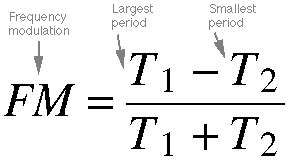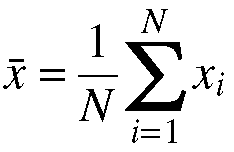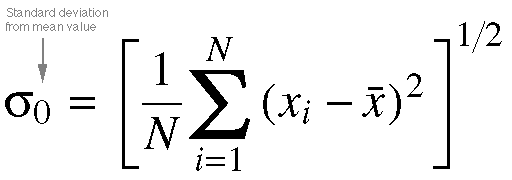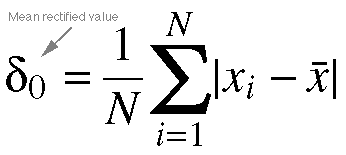Chapter 11:
Fluctuations and Perturbations in
Vocal Output

Equation 11.1. This
equation calculates the factor of amplitude
modulation (AM). The factor
is determined by taking the difference
between the maximum (A1)
and minimum (A2)
amplitudes, and dividing by the sum
of these two amplitudes. There are
two extreme cases: (1) when A2 =
A1,
there is no (0) modulation of the carrier
frequency, and (2) when A2 =
0, there is 100% modulation. In the latter
case, the carrier frequency has a amplitude
of zero, which is a violation of amplitude
modulation. In most cases, the amplitude
modulation factor is below 50 percent.

Equation 11.2. The method for determining the frequency
modulation (FM) factor is quite similar to that of determining amplitude
modulation. In this case, T1 and T2 are
the maxmimum and minimum periods, respectively. In the case where T2 =
0, the frequency (1/T) momentarily approaches infinity, which is a violation
of frequency modulation.

Equation 11.3. To determine the mean value of cyclic
variable of vocal fold vibration, one should calculate it in the standard
mean calculation method -- i.e., sum all (N) instances and divide
by the number of instances (again, N).

Equation 11.4. Mathematically, the above equation
is equivalent to equation 11.3. Sigma (S) is the
Greek letter equivalent to the Roman letter S. In mathematics, the sigma
notation represents summation. Below the sigma is the expression i=1,
which the initial value of i. N, which appears above the sigmal,
is the final value of i. Following the sigma is the expression to
be summed for all values of i. Hence, the sigma and the expression
following it in this case represent the sum of all values from x1 through xN.
This sum is then divided by the total number of instances (N) to determine
the mean or average value. When written out in its entirety, the equation
is exactly what is seen in equation 11.3.

Equation 11.5. To determine the zeroth-order perturbation
of the ith cycle, we need to take the difference between the value
of the ith cycle and the mean value. The resulting value is represented
by pi

Equation 11.6. Standard deviation is an important
concept in the realm of statistics. Its value is an indicator of the deviations
that the various instances (in this case, cycles) display from the mean as
a group. Standard deviation is calculated by summing the squared value of
the perturbation, dividing by the number of instances, and then taking the
square root of that value. Standard deviation is normally represented by
a lower case sigma (s). A subscript of 0 represents
that this standard deviation is of the zeroth order.

Equation 11.7. Another commonly calculated statistical
value is the mean recified value. This is determined by taking the
sum of the absolute value of the pertubations, and then dividing by the total
number of instances. Note the difference between this equation and the equation
to determine the mean (equation 11.3). The vertical bars indicate absolute
value, which is always the non-negative representation of a value. (e.g.,
the absolute value of -3 is 3.) Mean rectified value is normally represented
by a lower case lambda (l). As in equation 11.6,
a subscript of 0 represents zeroth order.

Equation 11.8. First-order perturbation is a ramp
-- in other words, it is the local linear trend made to the current point
from the last. The value k represents the overall mean rise per cycle,
and the expression (xi - xi-1) is the
rise between adjacent cycles.

Equation 11.9. We can apply the standard deviation
technique explained in Equation 11.6, although we must be careful. As we
are now analyzing the intervals between cycles rather than cycles themselves,
we have one less value to work with. (A simple analogy can be made -- while
you have five fingers, there are only four spaces between any two adjacent
fingers.) The initial value of i is hence set to 2, as we must account
for the term xi-1 equalling x1 in this
case, and the final value of xi will be xN.
Hence, when taking the standard deviation, while we square the perturbation,
we divide by one less than the number of cycles, and then again finally
take the square root. This time, a subscript of 1 is used to indicate the
first-order standard deviation.

Equation 11.10. The first-order mean rectified value
is calculated in a similar manner as equation 11.7, taking the same considerations
in mind as done with first-order standard deviation. Essentially, this value
is equal to the sum of the absolute values of the ramps divided by the number
of intervals. A subscript of 1 indicates first-order.

Equation 11.11. The last example of perturbation is
the second-order case, which represents removing a local linear trend (rather
than calculating it). This is calculated using the equation above (adopted
from Pinto & Titze, 1990).

Equation 11.12. To determine second-order mean rectified
value, we first need to divide the perturbation function by two -- this is
done such that the scale is similar to the first-order measures. As each
pertubation now spans two intervals (requiring three points), the range for i is
reduced again by one. This time, the range is from 2 (where the minimum value
of xi-1 is equal to x1) to N-1 (where
the maximum value of xi+1 is equal to xN).
We also reduce the divisor by 1 to N-2 to reflect this change. From there,
the standard approach of summing absolute values and dividing by the number
of instances should be clear. Again, the subscript 2 represents second-order.

Equation 11.13. Finally, standard deviation techniques
are applied to half of the expression in 11.11, again for scaling reasons.
The range and divisor are used for the same reason as for the mean rectified
value.
Chapter
10 Equations Equations
Homepage
| 


